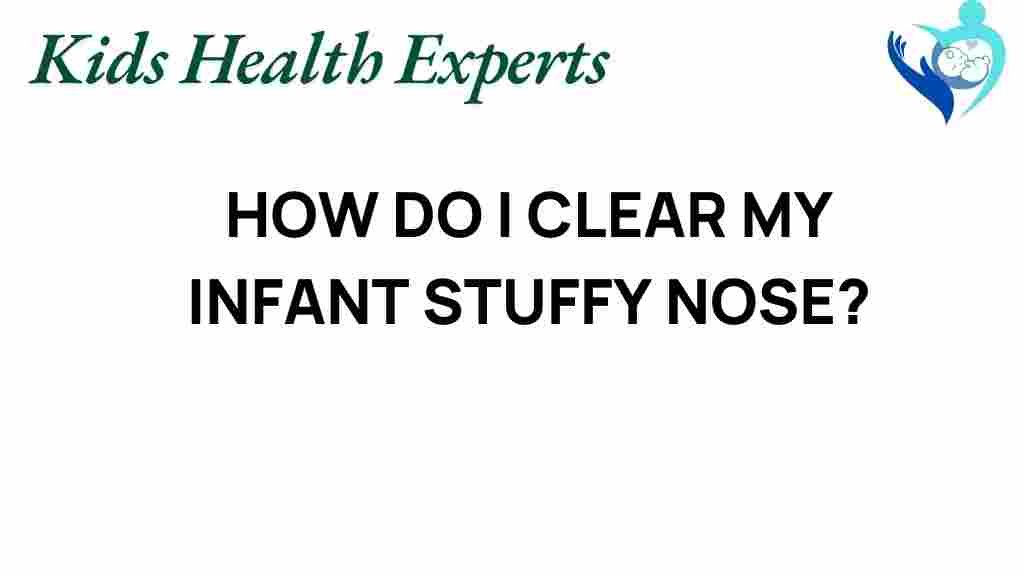Unlocking Secrets: How to Clear Your Infant’s Stuffy Nose
As a parent, witnessing your baby’s discomfort due to an infant stuffy nose can be distressing. Whether it’s due to seasonal allergies, a common cold, or other irritants, baby nasal congestion can interfere with your little one’s ability to breathe, eat, and sleep comfortably. Fortunately, there are effective strategies to provide breathing relief and restore your baby’s comfort. In this article, we will explore various home remedies, pediatric tips, and soothing techniques that can help you manage your infant’s nasal hygiene.
Understanding Infant Nasal Congestion
Before diving into solutions, it’s essential to understand why infants experience nasal congestion. Their nasal passages are smaller and more sensitive than those of adults, making them more prone to blockage. Common causes of infant stuffy nose include:
- Seasonal allergies
- Respiratory infections (like colds)
- Dry air or environmental irritants
- Teething (which can sometimes cause mucus production)
Recognizing the signs of nasal congestion in your baby is the first step towards providing relief. Symptoms may include:
- Difficulty feeding or breastfeeding
- Snoring or noisy breathing
- Irritability or restlessness
- Frequent coughing or sneezing
Step-by-Step Process to Clear Your Infant’s Stuffy Nose
Now that we understand the causes and symptoms, let’s explore effective methods to alleviate baby nasal congestion. Here’s a step-by-step guide:
1. Keep the Air Moist
Dry air can worsen nasal congestion. Use a humidifier in your baby’s room to maintain moisture in the air. This can help thin mucus and ease breathing.
2. Saline Drops
Administering saline nasal drops can loosen mucus and help clear your baby’s stuffy nose. Here’s how to do it:
- Purchase over-the-counter saline drops specifically formulated for infants.
- Lay your baby on their back.
- Gently squeeze 1-2 drops into each nostril.
- Wait a few moments, then use a bulb syringe to suction out the loosened mucus.
3. Suctioning the Nose
Using a bulb syringe can effectively remove mucus from your infant’s nose:
- Ensure the bulb syringe is clean.
- Pinch the bulb and insert the tip into your baby’s nostril.
- Release the bulb to create suction, which will draw out mucus.
- Remove and clean the syringe before repeating on the other nostril.
4. Elevate the Head
Keeping your baby’s head slightly elevated can promote better drainage. You can do this by:
- Placing a rolled towel under the mattress (not directly under the baby).
- Carrying your baby in an upright position while feeding or cuddling.
5. Warm Compress
A warm compress can soothe nasal passages and promote drainage. To use this technique:
- Soak a clean cloth in warm water and wring it out.
- Gently place the compress on your baby’s face for a few minutes.
Pediatric Tips for Managing Infant Stuffy Nose
Consulting with your pediatrician is crucial, especially if your baby is under three months old or has other health conditions. Here are some pediatric tips to consider:
- Monitor Symptoms: Keep track of how long your baby has been congested and any accompanying symptoms.
- Stay Hydrated: Ensure your baby is well-hydrated, as this can help thin mucus.
- Avoid Irritants: Keep your baby away from smoke, strong perfumes, or other potential allergens.
Troubleshooting Tips for Persistent Congestion
If your baby’s stuffy nose persists despite your efforts, consider these troubleshooting tips:
- Check for signs of fever or other illness. If present, consult your pediatrician.
- Evaluate for possible allergies. Seasonal allergies can often mimic cold symptoms.
- Assess the environment for potential allergens, such as pet dander or dust mites.
Soothing Techniques for Your Infant
In addition to physical methods of clearing nasal congestion, soothing techniques can help calm your baby during this uncomfortable time:
- Gentle Rocking: Holding and gently rocking your baby can provide comfort.
- White Noise: Using a white noise machine can help drown out other sounds and soothe your baby.
- Warm Bath: A warm bath can help relax your baby and may assist in clearing nasal passages.
Maintaining Nasal Hygiene
Good nasal hygiene is essential for preventing future episodes of infant stuffy nose. Here are a few practices to consider:
- Regularly clean your baby’s nasal passages using saline drops.
- Ensure your living environment is clean and free of dust or allergens.
- Encourage handwashing to prevent infections that can lead to congestion.
Seasonal Allergies and Infants
Seasonal allergies can also contribute to baby nasal congestion. If you suspect allergies, monitor your baby for symptoms during specific seasons. Common allergens include:
- Pollen from trees, grasses, and weeds
- Dust mites
- Pet dander
Consult with your pediatrician for appropriate testing and treatment options if allergies are suspected.
When to Seek Medical Attention
While home remedies can effectively manage mild cases of infant stuffy nose, it’s essential to know when to consult a healthcare professional. Seek medical attention if:
- Your baby is under three months old with a stuffy nose.
- Congestion is accompanied by a high fever or persistent cough.
- Your baby is having difficulty breathing or feeding.
- Symptoms last longer than 10 days.
Conclusion
Understanding how to manage your infant’s stuffy nose can significantly improve their comfort and well-being. From maintaining proper nasal hygiene to employing effective soothing techniques, parents have various tools at their disposal. Remember that while home remedies can be beneficial, consulting with a pediatrician is crucial for persistent or severe cases. Taking action early can ensure your little one experiences the breathing relief they need, allowing them to rest and thrive.
For more detailed information on infant care, visit our infant care section. Additionally, for research-based articles on allergies, check out this external resource.
This article is in the category Care and created by KidsHealthExperts Team
